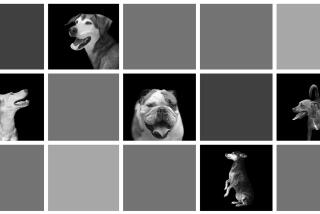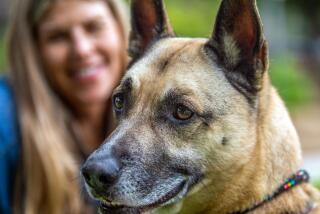Cats Replacing Dogs as Man’s Best Friend : Trend: Felines are the No. 1 pet in the United States. More working people are turning to cats, birds and miniatures that suit their busy lifestyles.
- Share via
BOSTON — Fifth-grade teacher Ilene Miller didn’t have a dog when she was growing up, but she dreamed of someday owning a golden retriever. Several months ago, that someday arrived, and a 3-month-old, buff-colored puppy named Kelsey became the third member of the Miller household in Newton, Mass.
“I adore this dog; she’s wonderfully affectionate--just packed with love,” said an ecstatic Miller, explaining how Kelsey fits into the active lives that she and her husband, Rob, a teacher and tennis pro, lead.
She agrees, however, that the situation might be different if the couple didn’t have a spacious yard, where a large wire-fence pen has been built to allow Kelsey to romp until her owners get home from work.
But for many city-dwelling, two-income families, big, frisky pets are a less practical option. As society changes, so does the world of companion animals.
Has an era of condo pets begun? Has the family dog--once part of the American dream--been displaced on the braided rug? And if not, is the United States turning into a nation of fat-cat, couch pooches?
These are some of the questions circulating in the companion animal field these days.
Among the foremost developments are the shift in the dog and cat population, the growing popularity of birds and the introduction of more sophisticated pet foods.
Numerically speaking, at least, dogs are no longer man’s best friend. Cats now outnumber dogs 57.9 million to 50.5 million, according to 1989 figures documented by the Pet Food Institute in Washington. Dogs, however, are found in a higher percentage of households, the American Veterinary Medical Assn. reports, a reflection that one dog per home is often enough, but cat lovers frequently have two or more feline pets.
The cat population has risen nearly 19% since 1984, when dogs last held the high ground, while the canine crowd has declined slightly.
Dogs are no less lovable; it’s just that changing lifestyles increasingly make cats the pets of choice. They often require less attention, which is a real plus with fewer stay-home owners, more single people and so many folks on the go.
“Cats are much more independent; they fare well on their own,” said Pat Farrell, manager of corporate communications for Ralston Purina, the largest U. S. pet food manufacturer. “Dogs, on the other hand, do best in a family environment or in a situation where someone’s going to be with them on a regular basis.”
With the increase in the number of working couples, dog ownership is no longer a clear option in the suburbs. And in the city, the proliferation of burglar alarms has eaten away at watchdog duties.
Dogs, of course, will always be welcomed in many homes, especially those in the country. But with pint-size pets offering certain advantages, will breeders attempt to downsize dogs?
Not likely, says Alan Beck, director of the Animal-Human Interaction Center at Purdue University in West Lafayette, Ind. “You don’t have to create new breeds; the ‘supermarket’ already has the choices,” he said. “There are more than 100 breeds, everything from toy poodles to the Newfoundlands.”
The American Kennel Club in New York keeps the most complete statistics on registered dogs. For the past six years, the cocker spaniel has been No. 1 on the list in the United States. That breed is followed by Labrador retrievers, poodles, golden retrievers and German shepherds. Clearly, not everyone is going for lap dogs, at least not based on pure-breed statistics.
Although conclusive evidence of dog-ownership trends is elusive because there are so many mongrels and unregistered dogs, people in the United States are clearly fascinated by scaled-down animals. Miniature horses, donkeys, rabbits and goats have all made major numerical strides during the last decade.
Although these animals aren’t necessarily meant as family-room companions, they are a more manageable size, and thus more economical. A miniature horse, for example, eats about a tenth of what his larger cousin does.
Beyond the advantageous size and cost factors associated with miniaturized animals, there is a distinctiveness that an unusual pet that affords its owner.
Then, too, greater familiarity broadens pet owners’ horizons. “Children are increasingly being exposed to a wider variety of companion animals in school programs, at pet stores and from seeing what their friends have,” said Linda Hines, executive director of the Delta Society, a national organization based in Renton, Wash., that studies human-animal bonding. “That helps to change the public perception of the desirability of these other animals.”
Describing the “Ark Nouveau,” Judith Stone writes in Discover magazine about the miniaturization, convenience and cachet that she sees as fashionable considerations for pet owners in the 1990s. “Folks want pets that are small and independent, pets that offer them a way to flaunt prosperity and individuality in a crowded, standardized world,” she said.
These factors help explain the rising popularity of birds, which are fourth in the pet hit parade behind fish, cats and dogs, according to a national survey by the American Pet Products Manufacturers Assn.
The American Veterinary Medical Assn. reports that the number of birds rose 24% to nearly 13 million during a four-year span of the 1980s. Parakeets and cockatiels continue to top the charts, but other exotic birds are moving up.
When domestically bred instead of plucked from the wild, these birds exhibit a high degree of sociability. They also lend a certain pizazz to urban living and don’t need to be walked.
Feeding one doesn’t cost much, but many U. S. pet owners aren’t inclined to skimp at mealtime anyhow.
Farrell of Ralston Purina indicates that two of the company’s super-premium dog foods, O.N.E. (Optimum Nutritional Effectiveness) and Pro Plan, are thriving.
Premium products are generally manufactured to be better looking and smelling to pet owners, but John Maxwell, a market analyst with Wheat First Securities in Richmond, Va., doesn’t see the gourmet foods as having much broad appeal. “It’s like Godiva chocolates,” he said. “They’re growing, but there are very few people really buying them.” The percentages look good, but the numbers of customers are just OK, he added.
Greater absolute growth is occurring with new pet snacks and “lite” foods, he says. The lite products, like their human namesakes, contain fewer calories. Animal snacks carry such people-appeal names as Ribz, Beggin’ Strips and Cheese Dawgs.
To some observers, these developments point to a trend in the humanization of pets. To others, however, it is just a continuation of the special treatment that pets have long been accorded.
More to Read
Sign up for Essential California
The most important California stories and recommendations in your inbox every morning.
You may occasionally receive promotional content from the Los Angeles Times.













